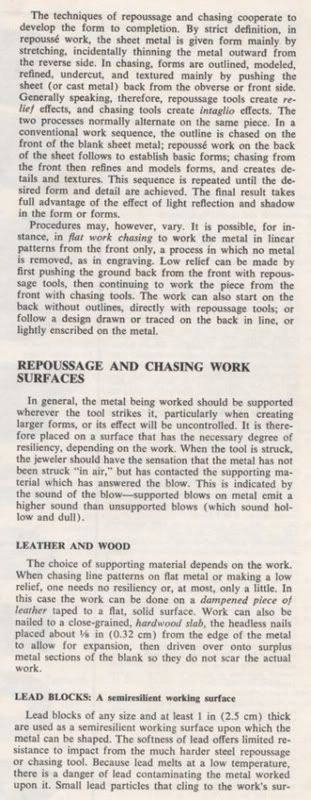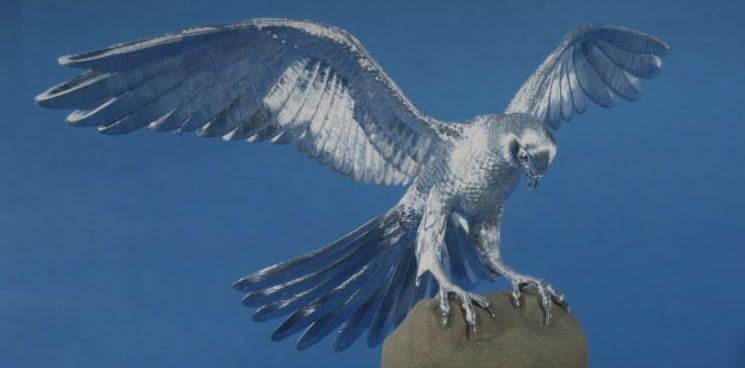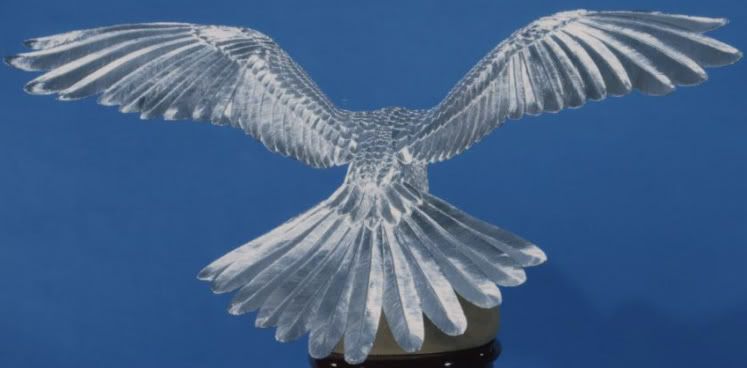
 |
|
|
|
|
#1 |
|
Member
Join Date: Dec 2004
Location: Orlando
Posts: 104
|
fernando
The grip seems to be of the Javanese shape. |
|
|

|
|
|
#2 |
|
Member
Join Date: Dec 2004
Location: What is still UK
Posts: 5,742
|
Technically speaking this is both repoussage and chasing. The repoussage {punching} can be applied on either side of the work. The highlights have been chased in {usually cutting as in engraving, to cut details in casting and other work}. This extract from "Jewelery concepts and technology" by " Oppi Untracht" A weighty tome the BIBLE for first year students, says stuff better than I can.

Last edited by Tim Simmons; 27th April 2008 at 07:02 PM. |
|
|

|
|
|
#3 |
|
Member
Join Date: Apr 2007
Location: Nothern Mexico
Posts: 458
|
Thank you, Tim. I discovered another thing from your languaje and found the source of confussion, as in spanish, or at least in Latin American spanish, we use the word "repujado" (repousée) in silversmithing only to the work done from the back, and chiseled to the work made from the front. We don´t have an equivalent of the word "chasing", and even in the dictionaries I just consulted right now, this word is traslated to spanish as "cincelado" or "chiselled". Is a confussion it just happens, like with the word "tempered", or in spanish "templado", which applied to steel thermal treatments in spanish means "hardened" and in english another thing. I will not commit the same error again.
With my best regards Gonzalo |
|
|

|
|
|
#4 |
|
Member
Join Date: May 2006
Posts: 6,736
|
Tim, I am not a silversmith, nor a jeweller, so I do not know terms as they are used in the trade. Within the trade, repousse and chasing could well carry the meanings you have given.
However, in standard English usage, repousse means :- "Of metal work. Raised or beaten into relief, ornamented in relief, by means of hammering from the reverse side." (Oxford) Chasing of metal work is actually an abbreviation of "enchasing", and it means :- "To adorn metal with work embossed or engraved in relief." (Oxford). Thus, this silver work could be designated as chasing, since the motif incorporates embossing work as well as engraving work. The word comes from Middle English, and can be applied to not only ornamental metal work, but also other types of indentation or grooving, or to the cutting of a screw. However, common usage would see this work designated as "embossing". The word "emboss" can be used in a number of various applications, but the one that would concern this discussion is:- "To carve or mould in relief." (Oxford) The silver work under discussion has been produced by a combination of moulding the motif in relief by the use of punches, and by engraving some of the details. All the ornamentation has been applied to the face of the object, it has not been applied from behind. It could be referred to as embossed work, or as chased work, but in standard English usage it would be incorrect to refer to it as repousse. As a supplementary comment I will add this:- I have spent a lot of time watching the craftsmen of Kota Gede near Jogjakarta doing this work. It is truly amazing to watch these people, most of the time they seem to work automatically, without any apparent effort or concentration on the work. In one workshop that is owned by a friend of mine, there are perhaps 20 or more men all working alongside one another, as they work they will be smoking, and chatting about the weekend's football match, or how many fish they caught. Their attention is not directed at the work they are doing, except when they come to some difficult detail, the rest of the time they are looking everywhere else but at the job, and their hands seem to work independent of themselves. Sometimes they will work to a photograph or sketch, sometimes a motif is sketched onto the silver and they follow that, mostly they work from memory. They will be told to emboss something with such and such a motif, they will put small guide marks around the edge of the job to help them keep the correct distribution of the motif over the work area, then they will work freehand, using a variety of punches to apply the motif in relief. |
|
|

|
|
|
#5 |
|
Member
Join Date: Dec 2004
Location: What is still UK
Posts: 5,742
|
This is an example of what we in the trade in the UK call chasing. A good chaser can make not so good work presentable, if there is the budget they can make work sparkle with life detail and grandeur. Like these feathers making them very life like in real space. wing span 35"
 
Last edited by Tim Simmons; 28th April 2008 at 07:33 AM. |
|
|

|
|
|
#6 |
|
Member
Join Date: Apr 2008
Posts: 4
|
dear fernando
allow me to introduce myself. My name is Dana, an edge weaponry enthusiast from Indonesia. I learn by asking several academician and Indonesian collectors...being a 9 to 5 office worker that i am, my information is limited. Fernando, indeed, a very beautiful badik you have there. first, i would like to share my very limited knowledge about Indo-Melayu edge weaponry. Badik originated from the Makassar, Bugis and Mandar ethnic tribe from Sulawesi and Palembang ethnic tribes in Sumatera. As seafarers tribes, their badik's also travels along, hence we found the "badek" in Malaysia and Thailand. There are two types of badik, indicated from its pamor, warangka or sheath. Badik saroso had pamor with gold or silver sheath sometimes also decorated with gems, while badik pateha had no pamor with soft wood for its sheath. Im guessing that your badik saroso is made around 17-18th century, once belonged to a "cultured" or high-positioned person, a royalty or a chief. I can say that not because of the beautiful silver mountings, but from the pamor of the badik. At that time, it is very unlikely that an average joe may possess a pamor weaponry. Your badik is not for fighting (several times maybe...) but for ceremonial purposes, wore at the front side of the clothing ceremonies. (like having a very beautiful hand-made tie wore in special occasions from a westerners point of view) like weddings, or peace-pact agreements. That may help explains the intricate silver decorations, to show social rank of the owner. For the beautiful silver sheath, is it original or added some other time later ? (again, im guessing that the silver is original) what kind of wood is it ? analyzing the type of wood may held detect the specific region of the badik itself. You may try to lightly tap the badik with wood or other metal. check how it sound. High frequency would indicate a high steel composition. Cant tell you anymore info. sometimes we just have to hold it to feel how its made..right ? additional info on badik : several site mentioned a badik originated from java. This is partly true. There are badik from jawa. The story goes that during the Jawa War or Prince Diponegoro War 1825-1830 (arguably the biggest and most expensive war ever fought by the dutch to conquer Prince Diponegoro) many bugis troops voluntarily travel to Jawaassisting Prince Diponegoro against the dutch. Surely, they bring along their badiks. In Jawaa, the javanese weaponsmith then reproduced the bugis troops badiks and swords, with a Jawanese "aura". my friend is very lucky to have found this Jawanese made badik. i'll ask him the picture later on. overall, a very beautiful badik. Please take a good care of it...its my national heirloom    im sure its in good hand im sure its in good hand    thats my 2 cents... sorry if my info is false or inaccurate. cheers fernando R. Yudhi Pradhana Prawiradirja beraswutah.blogspot.com Last edited by Beraswutah; 2nd May 2008 at 07:24 AM. |
|
|

|
|
|
#7 |
|
Member
Join Date: Dec 2004
Location: Orlando
Posts: 104
|
Some of you members might remember this one. This is about the largest piece that I have ever seen. The blade is about one foor long. The grip is marine ivory.
|
|
|

|
|
|
#8 |
|
Lead Moderator European Armoury
Join Date: Dec 2004
Location: Portugal
Posts: 9,647
|
Hi Dana
Thank you very much indeed for your input. Your mentioning that this is a nice piece is an added value, coming from an Indonesian  . .I have added to my collection files the extra info you posted, that i was not yet aware of. Fernando. |
|
|

|
 |
|
|